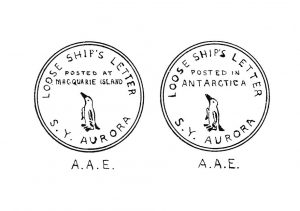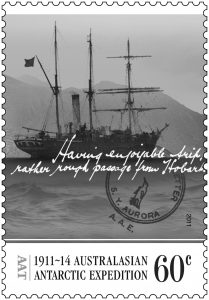- Author
- A.N. Other
- Subjects
- History - general, Ship histories and stories
- Tags
-
- RAN Ships
- None noted.
- Publication
- March 2012 edition of the Naval Historical Review (all rights reserved)
By Richard Breckon
Sir Douglas Mawson’s Australasian Antarctic Expedition of 1911–14 marked the effective commencement of Australian involvement in Antarctica – the subject of 100-year celebrations recently. The ship carrying the expedition members, S.Y. Aurora, had a significant connection with the Antarctic before its mysterious demise in the Pacific. Notably, Aurora carried the first mails between Australia and Antarctica.
Originally built in 1876 for whaling and sealing ventures, Aurora was purchased by Douglas Mawson for his expedition. During a two-year period, Aurora undertook several voyages involving the establishment of Australian bases on Macquarie Island and the Antarctic mainland.

Special handstamps were provided for use on mail written by expedition members on board Aurora. The circular design featured a penguin surrounded by the inscriptions “Loose Ships Letter / S.Y. Aurora”; “Posted at / Macquarie Island” (first type of handstamp) or “Posted in / Antarctica” (second type); and “A.A.E.” (Australasian Antarctic Expedition). “Loose Ship’s Letter” identified mail lodged onboard a ship for onward posting at the first Australian port-of-call.
Mawson’s expedition departed from Hobart on 2 December 1911, reaching Macquarie Island 10 days later. The expedition’s first outwards mail, featuring the “Posted at Macquarie Island” handstamp, was taken back to Hobart by a support vessel, S.S. Toroa. The letters were postmarked in Hobart on 21 December and sent onwards to their destinations.

Aurora left Macquarie Island on 25 December 1911, proceeding to Antarctica, where land parties established bases at Commonwealth Bay, and in Queen Mary Land, about 2,400 kilometres to the west. Leaving Antarctica, Aurora reached Hobart on 12 March 1912, carrying mail featuring the “Posted in Antarctica” handstamp.
On 20 May 1912, Aurora made a voyage to Macquarie Island and brought back mail to Hobart. On 26 December 1912, Aurora again left Hobart to relieve the two Antarctic bases, Hobart being reached on 15 March 1913. In late 1913, Aurora made its final voyage to bring home the remaining expeditioners (including Mawson), who reached Adelaide on 26 February 1914.
Aurora’s return voyages carried letters to Australia; the unstamped mail being franked on arrival with one penny stamps purchased by the exhibition organisers. The basic rate of letter postage within Australia and the British Empire at the time was one penny.
Aurora had two further voyages to Antarctica. In May 1915, as a support ship for Ernest Shackleton’s Imperial Trans-Antarctic Expedition of 1914–17, during which Aurora was caught in ice for nine months. The second voyage was the 1917 Ross Sea Relief expedition to bring back the marooned party when Aurora was ice-bound in 1915.
On a voyage carrying a cargo of coal between Australia and Chile in 1917, Aurora and its crew of 21 mysteriously disappeared.
